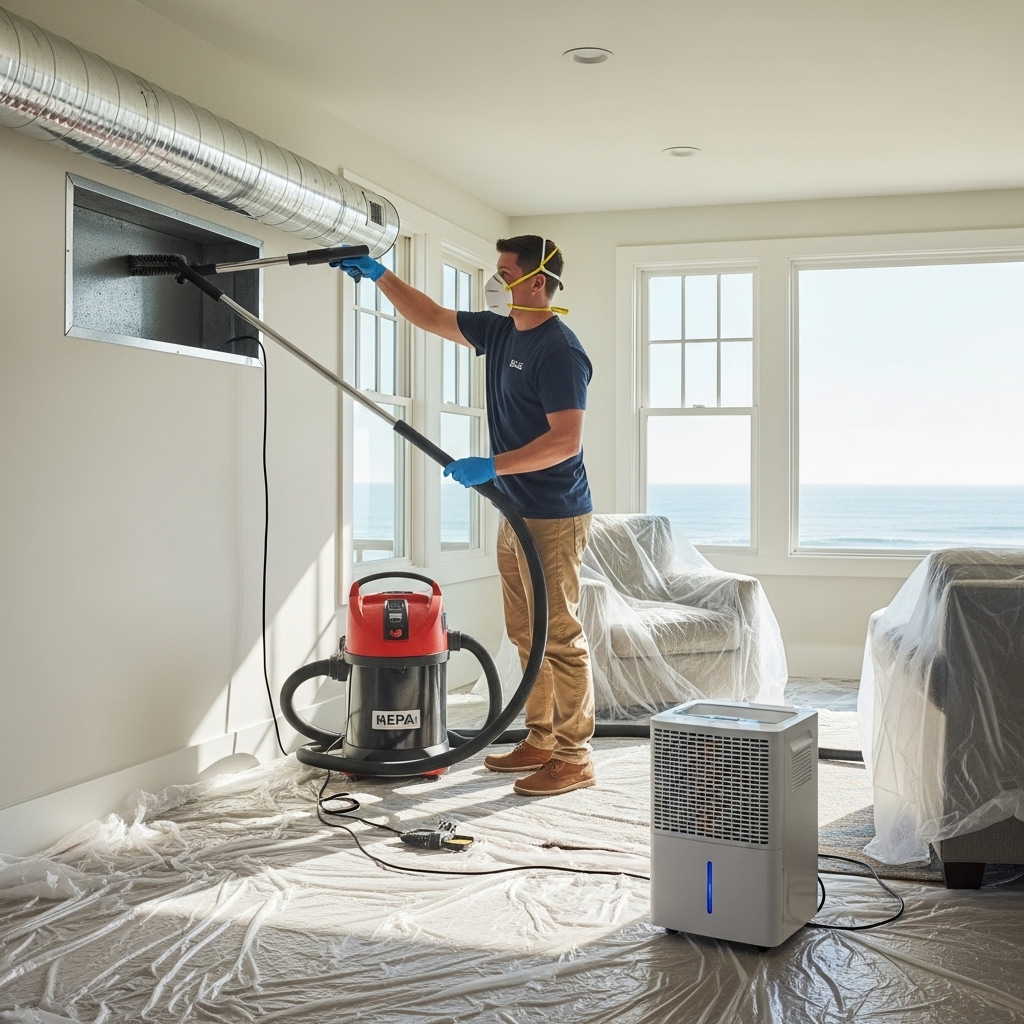Introduction
Clean, healthy indoor air is essential in every Malibu home, where ocean breezes can mingle with coastal salt, seasonal humidity, and, at times, wildfire particulates. If you are ready to restore airflow, reduce allergens, and help your HVAC system run more efficiently, this step-by-step guide will show you how to perform air duct cleaning with care and confidence. Whether you plan to DIY or prepare for a professional visit, you will learn exactly what to do, what to avoid, and how to tailor each step to Malibu’s unique climate conditions. For homeowners who prefer expert assistance or want to verify their approach against industry best practices, consider consulting a trusted air duct cleaning resource while you follow along.
Because Malibu homes often sit close to the shoreline or in canyons that can be dusty or wind-exposed, ductwork may collect a blend of salt-laden dust, pet dander, pollen, fine ash, and construction debris. Over time, this buildup can restrict airflow and re-circulate irritants. The good news is that with careful preparation, the right tools, and a methodical workflow, you can substantially improve air quality and make your living spaces feel fresher, more comfortable, and less burdened by lingering odors.
Safety First and Essential Tools
Before you begin, think about safety, cleanliness, and the ability to control dust. Protect yourself and your home with basic PPE, and set up containment so dust does not escape into living areas. Malibu’s seasonal humidity can also increase the risk of microbial growth, so keep everything dry, clean, and organized.
- N95 or better respirator mask to avoid inhaling fine dust and particulates
- Protective eyewear and gloves
- Drop cloths or plastic sheeting for containment around vents and work areas
- Painter’s tape to secure coverings
- Flashlight or headlamp for duct inspections
- Long-hose vacuum with HEPA filtration to capture fine particles
- Soft-bristle brush and microfiber cloths to dislodge dust without damaging surfaces
- Extendable brush rods for deep reaches in straight duct runs
- Screwdriver set to remove vent registers and access panels
- HVAC-rated coil cleaner for the evaporator coil (if accessible and permitted by system warranty)
- New HVAC filter that matches your system’s specifications
Always switch off your HVAC system at the thermostat and, if necessary, the electrical disconnect before you open any panels. Avoid using harsh chemicals inside the ductwork; mild detergent and light mechanical agitation are typically safer for both your system and your indoor air.
Malibu-Specific Considerations
Salt air can slowly oxidize metal, and sticky sea mist may make dust adhere more firmly to grilles and ducts. In the late summer and fall, regional wildfires can send fine ash into outdoor air, some of which can enter return pathways. It is wise to increase inspection frequency during these seasons, and to run high-efficiency filtration (MERV 11–13 where compatible) to capture finer particles. For homes near canyons or busy roads, be mindful of elevated dust and pollen; for oceanfront homes, keep an eye on surface corrosion and condensation that might trap grime.
Pre-Work Setup and Containment
- Turn off the HVAC system and confirm the blower is not running.
- Lay drop cloths beneath supply and return registers to catch debris.
- Use painter’s tape to seal surrounding areas you will not be cleaning today.
- Open windows slightly, weather permitting, to ventilate airborne dust safely outdoors.
- Gather your vacuum, brushes, cloths, and a bucket with mild detergent solution for grilles.
- Photograph each vent and connection you remove to aid reassembly.
Step-by-Step Duct Cleaning Process
- Remove and Wash Registers: Unscrew each supply and return register. Soak metal registers in warm, soapy water, rinse, and dry thoroughly to prevent rust. Wipe wood or specialty grills with a damp microfiber cloth.
- Surface Dusting: Use a soft brush to loosen dust on the edges of each duct opening. Carefully vacuum the loosened debris with a HEPA unit, avoiding hard impacts that might bend or puncture duct material.
- Initial Vacuuming: With an extendable hose, vacuum as far into each straight run as you can reach. Work methodically from one side of the home to the other so you do not miss vents.
- Agitation in Straight Runs: Connect brush rods and gently rotate to dislodge adhered dust. Avoid aggressive force that could separate joints or tear flexible ducting.
- Return Duct Focus: Give special attention to return ducts, which tend to accumulate heavier dust. Slowly guide the vacuum hose along the bottom of the return as you agitate with a brush.
- Branch Connections: Where accessible, clean junctions where branches meet main trunks. These can collect pockets of debris, especially after renovations or periods of heavy outdoor dust.
- Blower Compartment: If you are comfortable and permitted by warranty, remove the access panel and vacuum around the blower housing and accessible surfaces. Do not disturb wiring. Wipe reachable surfaces with a lightly damp microfiber cloth, keeping moisture to a minimum.
- Evaporator Coil Proximity: If the coil is visible and accessible, gently vacuum the face of the coil using a brush attachment and, if needed, apply a coil-safe cleaner per label directions. Ensure complete drying before reassembly to prevent mildew odors.
- Plenum and Main Trunk: Carefully vacuum the accessible plenum area and main trunk sections you can reach, taking care not to dislodge sealing tapes or mastic.
- Replace Air Filter: Install a new filter of the correct size and MERV rating compatible with your blower. A high-efficiency filter can help protect the freshly cleaned ductwork.
- Reassemble and Reseal: Reattach registers once they are completely dry. Verify that screws are snug and that no gaps or rattles remain.
- System Start-Up Test: Power on the system and let it run for 10–15 minutes. Walk room to room, listening for unusual noises and confirming steady airflow.
Addressing Odors, Residues, and Moisture
Musty or salty odors may persist if moisture or sticky residues remain. In Malibu, do not overlook humidity management. Run bath fans, use a dehumidifier when necessary, and improve coastal cross-ventilation during drier hours. If there was smoke exposure in your neighborhood, replace filters more frequently immediately after an event and clean grilles twice to reduce lingering smells. Avoid heavy fragrances; focus on source removal, dryness, and fresh air exchange.
Quality Check and Documentation
After cleaning, shine a flashlight into several vents and take new photos to compare against your “before” images. You should see less dust accumulation, fewer cobwebs, and cleaner surfaces. Note your filter change date and cleaning steps in a household maintenance log so you can track performance over time. Good documentation helps you maintain consistency and quickly diagnose any future airflow changes.
Ongoing Maintenance Schedule for Malibu Homes
- Monthly: Inspect the filter and replace if dirty, especially during high-dust or high-pollen periods.
- Seasonally: Wipe down supply and return grilles, vacuum the first few feet behind each register, and check for loose screws or rattling.
- Biannually: Inspect the blower compartment and evaporator coil accessibility. Clean lightly if you are qualified and it is allowed by your warranty.
- Annually: Perform a more thorough duct check, focusing on returns and main trunks. Consider professional inspection before peak cooling or heating seasons.
- Post-Event: After a nearby wildfire or construction project, conduct an extra filter change and spot cleaning.
Common Mistakes to Avoid
- Over-wetting: Moisture invites microbial growth. Keep cleaning solutions minimal and dry surfaces promptly.
- Harsh Chemicals: Solvents can damage duct materials and degrade indoor air quality.
- Forcing Brushes: Aggressive agitation can puncture flex duct or compromise seals.
- Ignoring Returns: Returns often contain the heaviest dust loads; do not neglect them.
- Skipping Filter Upgrades: Using a poor-quality filter can undermine your hard work.
DIY or Professional Support?
A careful homeowner can accomplish a meaningful refresh, especially on registers, returns, and straight runs. However, complex layouts, inaccessible trunks, suspected contamination, or signs of moisture problems benefit from expert tools and training. Specialists can apply negative pressure, reach deep bends, and verify system integrity from end to end. If you want a deeper clean, a performance audit, or help validating results, look for reputable Malibu providers and compare their process to established best practices for professional air duct cleaning. The right partner will discuss containment, filtration, agitation methods, and post-cleaning verification, giving you confidence that your system will stay efficient and clean.
FAQ
Q: How often should Malibu homeowners clean their air ducts? A: Inspect annually and clean as needed. Homes near the ocean or canyon winds, or those affected by wildfire smoke, may benefit from more frequent attention and filter changes.
Q: Will cleaning ducts reduce allergies? A: It can help by lowering dust, pet dander, and pollen recirculation. Pair cleaning with high-quality filtration and good humidity control for the best results.
Q: Can I use scented disinfectants in ducts? A: It is safer to avoid strong fragrances or harsh chemicals. Focus on physical removal of dust and moisture management. If disinfection is necessary, consult your HVAC manufacturer and a qualified professional.
Q: What about mold? A: If you suspect mold, address moisture first, confirm with a qualified assessment if possible, and clean or remediate according to recognized guidelines. Prevent recurrence with proper drainage, dehumidification, and regular filter changes.
Q: Do I need to clean after renovations? A: Yes. Construction dust travels easily into returns and can settle in ductwork. Change filters more often during and after projects.
Q: Will duct cleaning improve HVAC efficiency? A: It can support efficiency by removing obstructions and protecting coils and fans from dust buildup. Proper sealing and insulation of ducts further improve performance.
Ready to Breathe Cleaner Air in Your Malibu Home Today
If you want expert eyes on your system, help with hard-to-reach trunks, or a thorough post-wildfire or post-renovation cleanup, schedule a visit with a trusted air duct cleaning service. With thoughtful maintenance and the right support, your Malibu home can enjoy fresher air, smoother airflow, and a more comfortable living environment throughout the year.

